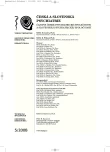Dissociation in Childhood: Clinical Manifestation and Diagnosis Child Dissociative Checklist
Authors:
J. Soukup; H. Papežová
Authors‘ workplace:
Psychiatrická klinika 1. LF UK a VFN, Praha
přednosta prof. MUDr. J. Raboch, DrSc.
Published in:
Čes. a slov. Psychiat., 104, 2008, No. 5, pp. 236-240.
Category:
Comprehensive Reports
Overview
Dissociative symptoms in children are often a reaction to stimuli that are beyond the child‘s coping abilities. Dissociation has a protective function, but when it persists, it negatively influences child’s quality of life, psychological development, social relationships and perspective of education. Focusing our attention to possible dissociation and making use of test results, observation, clinical interview and information from child’s parents or teachers is necessary for making the diagnosis. The differential diagnosis of dissociative disorders in children include attention deficit disorders, conduct disorders, rapid cycling bipolar disorder, psychotic disorders, epilepsy, and personality disorders. Presented version of Child dissociative scale is Czech translation of a valid and reliable screening scale for measuring dissociation in children.
Key words:
dissociation, trauma, Child Dissociative Checklist.
Sources
1. Diseth, T. H.: Dissociation following traumatic medical treatment procedures in childhood: a longitudinal follow-up. Developmental Psychopathology, 18, 2006, 1, pp. 233-251.
2. Hort, V., Hrdlička, M., Kocourková, J., Malá, E. a kol.: Dětská a adolescentní psychiatrie. Praha, Portál, 2000.
3. Chalupníček, A.: Disociativní poruchy a paranoidní schizofrenie. Diplomová práce. Brno, Masarykova univerzita, Fakulta sociálních studií, 2008, publikováno na: http://is.muni.cz/th/65618/fss_m/?lang=en.
4. International Society for the Study of Trauma and Dissociation: Guidelines for the evaluation and treatment of dissociative symptoms in children and adolescents, 2003. Publikováno na: http://www.isst-d.org/education/ treatmentguidelines-index.htm.
5. Kocourková, J., Koutek, J., Propper, L., Hort, V.: Dissociativní porucha identity u dětí a adolescentů. Česká a slovenská psychiatrie, 97, 2001, 2, s. 60-63.
6. Macfie, J., Cicchetti, D., Toth, S. L.: Dissociation in maltreated versus nonmaltreated preschool-aged children. Child Abuse and Neglect, 25, 2001, pp. 1253-1267.
7. Perry, B. D.: Fear and learning: Trauma-related factors in the adult educational process. New Directions for Adult and Continuing Education, 110, 2006, pp. 21-27.
8. Perry, B. D., Szalavitz, M.: The boy who was raised as a dog. New York: Basic Books 2006, 275 p.
9. Peterson, G., Putnam, F. W.: Preliminary results of the field trial of proposed criteria for dissociative disorder of childhood. Dissociation, 7, 1994, 4, pp. 212-220.
10. Putnam, F. W.: Dissociation in children and adolescents. New York: Guilford, 1997, 423 p.
11. Putnam, F. W., Helmers, K., Trickett, P. K.: Development, reliability, and validity of a child dissociation scale. Child Abuse and Neglect, 17, 6, 1993, pp. 731-741.
12. Putnam, F. W., Peterson, G.: Further validation of the Child Dissociative Checklist. Dissociation, 7, 1994, 4, pp. 204-211.
13. Soukup, J.: Disociativní procesy a poruchy v dětství a adolescenci. Rigorózní práce. Praha, Univerzita Karlova, Fakulta filozofická, 2005, publikováno na: http://www.psycholousek.cz/downloads/rigo_honzas.pdf.
14. Van der Hart, O., Nijenhuis, E., Steele, K.: The haunted self. structural dissociation and the treatment of chronic traumatization. New York, Norton, 2006, 418 p.
15. Vermetten, E., Dorahy, M. J., Spiegel, D.: Traumatic dissociation: Neurobiology and treatment. Washington, American Psychiatric Publishing, 2007, 372 p.
16. Waters, F. S.: What’s really going on with this child?: Understanding and treating traumatized children with dissociation. Presented at European Society for Trauma and Dissociation conference, Amsterdam, 2008.
Labels
Addictology Paediatric psychiatry PsychiatryArticle was published in
Czech and Slovak Psychiatry

2008 Issue 5
Most read in this issue
- Dissociation in Childhood: Clinical Manifestation and Diagnosis Child Dissociative Checklist
- Catamnestic Observation of the Efficacy of Substance Dependence Treatment Program
- Criminal Liability Assessment in Defendants with History of „Schizophrenia“ - Case Study of Institutional Revision Report
- Circadian Rhythms in Major Depressive Disorder
